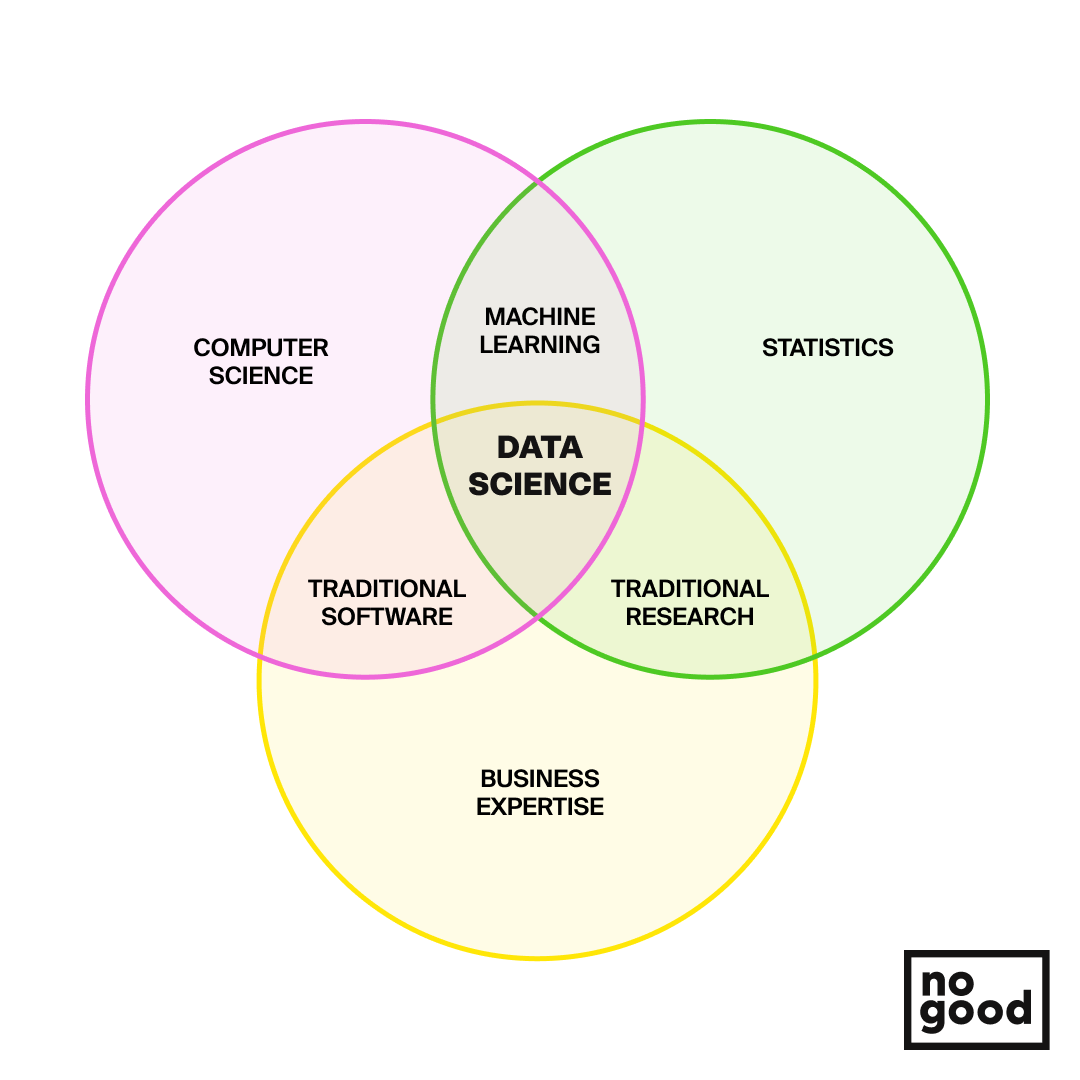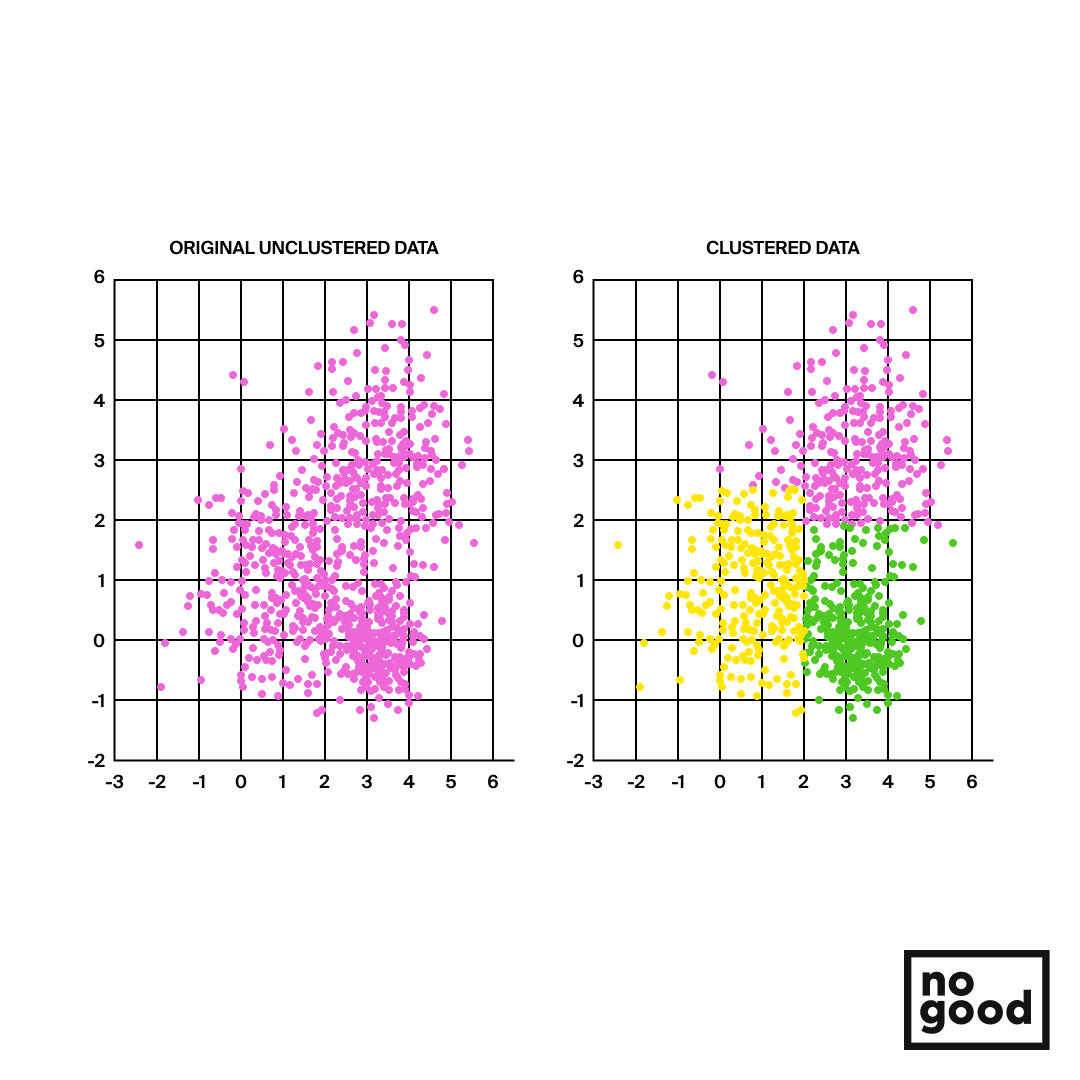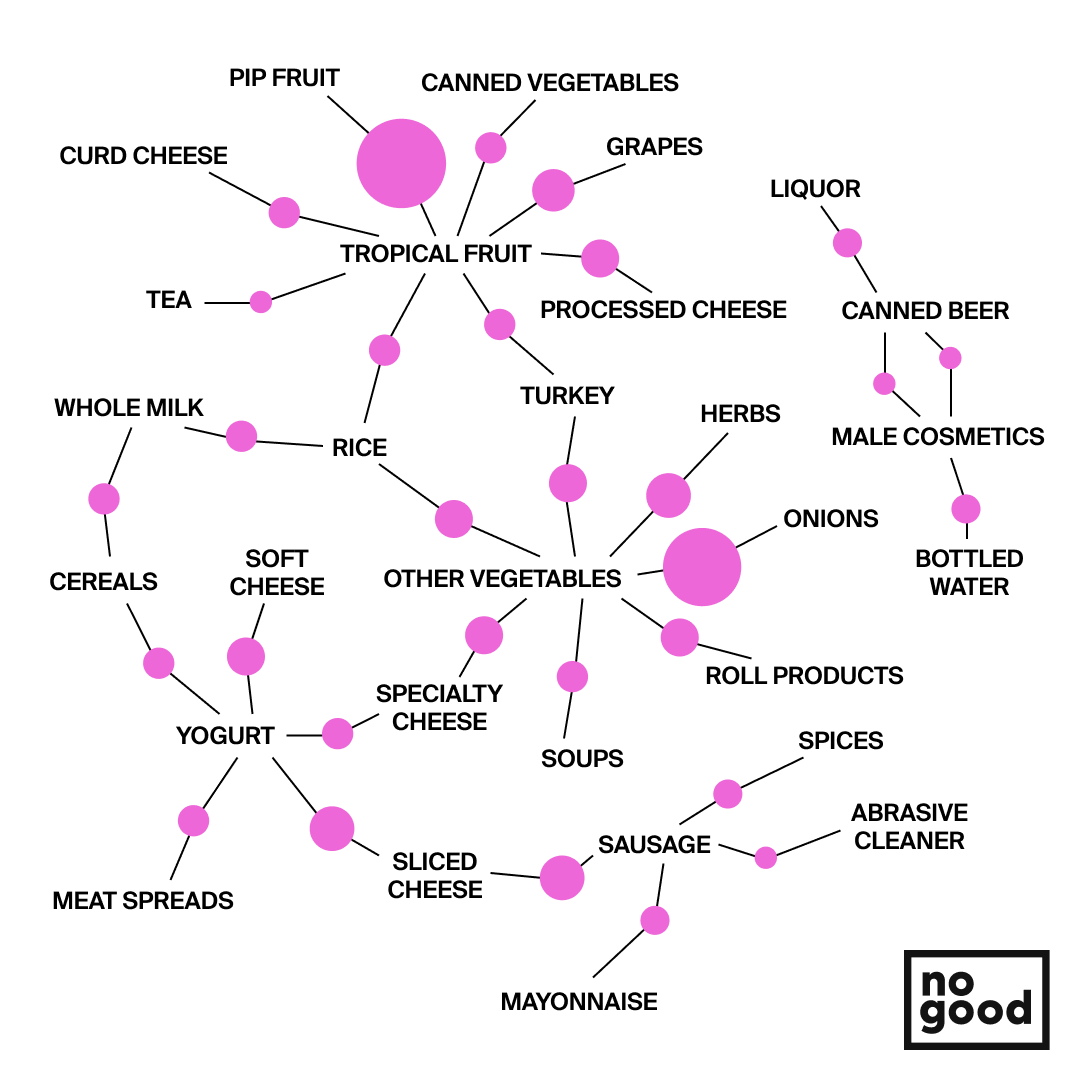Data science is an indispensable aspect of modern marketing. Businesses incorporate data science into their marketing strategy to make informed decisions based on actionable insights derived from vast quantities of data.
Successful marketing requires a deep understanding of customers’ needs, wants, and pain points. Data science provides the tools and techniques needed to collect, analyze and interpret customer behavior.
Data science is relevant to marketing in multiple ways. Let’s dissect how data science helps marketers understand their customers, make data-driven decisions, and optimize their digital marketing strategies for maximum impact.
In this article, we’ll take a look at:
- Marketing applications of data science
- Benefits of data science in marketing
- How to become a data scientist
- Use cases: how large companies use data science to their benefit
What is Data Science?
Data science is an interdisciplinary field that combines statistical analysis, machine learning, and computer science to extract insights from structured and unstructured data. Data science involves the use of various analytical and statistical methods to extract meaningful information from large data sets, allowing businesses to make informed decisions and gain a competitive advantage.

Can Data Scientists Work in Marketing?
Yes, data scientists can (and should) work in marketing. Data science is increasingly vital to marketing as companies seek to use data to drive their marketing strategies. Data scientists can help marketers by analyzing customer data, identifying patterns, developing predictive models to forecast consumer behavior, and using machine learning algorithms to optimize marketing campaigns. Data scientists can also work with marketing teams to develop new products and services, improve customer experiences, and optimize pricing strategies.
Let’s take a look at how data scientists can add value to marketing teams.
How Is Data Science Used in Marketing?
Data science plays a vital role in marketing by enabling businesses to personalize marketing campaigns, enhance marketing effectiveness, and make data-driven decisions. By leveraging data science techniques such as machine learning, predictive modeling, and natural language processing, you can extract valuable insights from large volumes of customer data, including social media conversations, online behavior, and purchase history. Let’s take a look at some specific applications of data science in marketing:
Customer segments
Segmentation is a marketing technique that involves dividing customers into distinct groups. To create customer segments, data scientists first collect and analyze data on customer demographics, behavior, and preferences. This data can come from transactional data, social media, web analytics, and/or customer surveys. They then use machine learning algorithms to identify patterns and similarities among customers and group them into segments. This is typically done using predefined criteria, such as demographics, psychographics, and behavioral data. Dividing audiences into customer segments enables you to create targeted and personalized marketing campaigns that resonate with specific consumer groups.
Clustering
Clustering uses statistical and machine learning techniques to identify patterns and group customers or products based on their shared characteristics, behaviors, and preferences. As opposed to customer segmentation, clustering is done without predefined criteria and is more exploratory in nature.
Clustering is an example of unsupervised machine learning. In unsupervised machine learning, the algorithm is trained on an unlabeled data set where the outcome variable is unknown. Its goal is to identify patterns in the data without a specific target variable.
Clustering can be used to inform segmentation by identifying groups of customers with similar characteristics. By using this method, marketers can create more accurate and effective customer segments.

Above, we can see how the dataset has been organized into clusters. This is an effective way to identify customer segments that, for example, are more likely to purchase a particular product or are more likely to churn. This information can be used to inform predictive modeling.
Predictive modeling
Predictive modeling is the process of using statistical and machine learning algorithms to create models that predict future outcomes based on historical data. Predictive modeling can be used to predict customer churn, estimate the expected customer lifetime value (CLV), score and rank leads based on their likelihood to convert, recommend products or services to customers based on their purchase history and preferences, and optimize spend across different channels.
Channel optimization
Channel optimization refers to the process of determining the most effective marketing channels for reaching and engaging with target customers. This involves analyzing customer behavior, preferences, and engagement metrics across various channels such as email, social media, search engines, and display advertising.
By leveraging machine learning algorithms and advanced analytic tools, you can identify the channels that are most effective at reaching your target audience and driving engagement and conversions.
Buyer personas
Data science techniques such as clustering and segmentation can be used to group customers based on shared characteristics and interests, which is crucial for developing accurate buyer personas. Predictive modeling can also be used to identify the characteristics of customers who are most likely to convert into paying customers, helping refine buyer personas further. By using data science to create more accurate buyer personas, you can develop highly effective, personalized, and targeted marketing strategies.
Personalization and targeting
Personalization and targeting are key components of modern marketing. Data science plays a critical role in enabling these capabilities. By applying data science techniques, you can segment customers based on their behavior, demographics, and other attributes. You can then target these customer segments with personalized messages and offers that are tailored to their specific needs and pain points. These targeted messages can be delivered via a range of channels, including web content, email marketing, and targeted marketing campaigns.
One specific and highly effective personalization technique is building recommender systems. Recommender systems use data science algorithms to suggest products or services to customers based on their past behavior and preferences. By delivering more relevant product recommendations, you can increase the likelihood of conversion and drive revenue growth. Other personalization techniques, such as dynamic pricing, can also help better engage customers and drive conversion rates.
Pricing Strategy
Marketers can use data science to analyze customer purchase patterns and identify cross-selling and upselling opportunities. By understanding customer behavior, you can develop targeted pricing strategies and product bundles that increase sales and customer loyalty.
Customer loyalty
Implementing data science to improve customer loyalty is a highly effective method to reduce churn. By using predictive modeling to identify customers at risk of churning, or leaving the brand, you can proactively engage with them to address their concerns and retain their loyalty.
Sentient analysis (we’ll get to that next) can also be implemented to identify areas for improvement in the customer experience. By addressing pain points and improving the customer experience, brands can build stronger relationships with their customers and foster greater loyalty.
Sentiment analysis
Sentiment analysis is used to identify and analyze the sentiment, or emotion, expressed in text data such as customer reviews, social media posts, and blog comments. Sentiment analysis provides insight into how customers feel about a particular product or brand. This data helps identify areas of improvement.
Data scientists analyze large amounts of unstructured text data to identify patterns and trends in customer sentiment. Natural Language Processing (NLP) is a subfield of data science (specifically, a branch of artificial intelligence) that focuses on understanding and analyzing human language. NLP is the primary AI marketing tool used in sentiment analysis. NLP identifies words and phrases that are commonly associated with positive or negative sentiment. For example, words such as “great,” “amazing,” and “awesome,” are associated with positive sentiment, while words like “disappointing,” “terrible,” and “awful,” are associated with negative sentiment.
Automation
You can leverage customer sentiment analysis and predictive analysis to enhance automated customer support on a large scale. For instance, businesses can use natural language processing and machine learning techniques to train chatbots to understand and respond to customer inquiries. This enables businesses to provide quick and personalized support, improving overall customer experience.
Lead scoring
Lead scoring is a technique used to identify and prioritize the most promising leads. This is done by assigning a numerical score to each lead based on a variety of factors such as online behavior and engagement with marketing materials. For example, a lead may be assigned a higher score if they have visited your company’s website multiple times, attended a webinar, or downloaded a whitepaper. On the other hand, a lead may be assigned a lower score if they have not engaged with your company’s marketing materials or have unsubscribed from marketing emails.
By using machine learning algorithms and other advanced analytic tools, data scientists can build predictive models that identify key factors contributing to lead conversion, allowing them to score leads with greater accuracy and precision.
Market Basket analysis
Market basket analysis is a data analysis technique used to identify relationships between products that are frequently purchased together. These sets of products are referred to as “itemsets.” The frequency with which itemsets occur is measured using metrics such as support, confidence, and lift. Support measures the frequency with which a particular itemset occurs in a dataset, while confidence measures the likelihood that one item will be purchased given another has already been purchased. Lift measures the degree to which the occurrence of one time influences the occurrence of another item.
You can use insights from a market basket analysis to optimize product offerings, pricing strategies, and promotional campaigns. For instance, a retailer might create bundle deals to encourage customers to purchase related items together, based on the analysis of frequently purchased items. Market basket analysis can also be used to identify opportunities for cross-selling and upselling, as well as to understand how changes in product offerings or pricing affect customer behavior.
Regression analysis
Regression analysis is used to analyze the relationship between a dependent variable (such as sales) and one or more independent variables (such as digital advertising spend or price). By using regression analysis, you can gain insights into how changes in the independent variable impact the dependent variable, allowing you to make data-driven decisions about pricing, promotions, and advertising spend. For instance, you can use regression analysis to understand how changes in your advertising spend impact sales; you can then optimize your advertising budget accordingly.
Affinity analysis
To perform affinity analysis, data scientists use machine learning algorithms and statistical models such as Apriori, FP-Growth, or the Eclat algorithm. These algorithms work by searching for frequent item sets and then identifying the associations between those item sets.
Insights from an affinity analysis can be used to improve product recommendations, optimize product assortments, and create targeted marketing campaigns. Affinity analysis can be used to identify relationships between a wide range of items, behaviors, or events, whereas market basket analysis is focused on analyzing purchasing behavior.
Below is a visual depiction of an affinity analysis for grocery items. Using an affinity analysis can reveal patterns, such as the association between male cosmetics and bottled water purchases. This data analysis can help you develop targeted and personalized strategies.

Social media marketing
Data science is a crucial tool in social media marketing as it allows you to extract insights from large volumes of social media data. By using natural language processing and machine learning algorithms, data scientists can analyze social media conversations and identify patterns in consumer behavior and sentiment. These insights inform social media strategies such as content creation, messaging, and targeting.
Additionally, data collected can be used to analyze the performance of social media content and optimize it for better reach and engagement. You can use A/B testing, predictive modeling, and other data-driven techniques to test and refine your social media strategies.
Data science also allows you to identify and target influencers whose audiences align with your brand, and measure the effectiveness of such partnerships. This includes measuring engagement rates, conversion rates, and the impact on brand awareness and sentiment.
Lastly, you can use data science to optimize ad placement, ad format, and other variables to maximize the effectiveness of their social media campaigns. This helps you reach the right people with the right message, ultimately driving more conversions and revenue.
Real time interaction
Natural language processing and machine learning can be used to analyze customer data in real-time. This helps optimize customer interactions by providing personalized and relevant content in real-time.
Another benefit of using data science is that it helps you understand how customers interact with your brand in real-time. By leveraging real-time data and analytics, brands can quickly adjust their marketing strategies to better connect with their customers, improve their experience, and increase engagement and loyalty.
Additionally, incorporating data science into growth experimentation can help you test scenarios and experiments in real-time, which was previously not possible. Analyzing customer sentiment and feedback about product or brand attributes is a crucial skill for modern marketing teams as it allows you to tailor your campaigns to your audience’s preferences and needs.
The ability to experiment and optimize in real-time is a powerful advantage in today’s fast-paced and competitive business landscape.
Marketing budget optimization
Data science can help you optimize our budgets in several ways. One way is via predictive modeling, where data scientists can analyze historical data to forecast customer behavior. Understanding these insights gives you a better idea on where to allocate your budgets and how much to spend on each channel to get the highest return on investment. Response rates can also be analyzed to determine which channels are the most successful in reaching and engaging with customers. This data-driven approach to budget optimization can help you make informed decisions and drive better results, leading to more effective and efficient use of resources.
Product Development
By analyzing large volumes of customer data, you can gain insights into what features or improvements are most desired by customers and develop products that meet their needs.
Data science will help you match the right product with your customer. By looking at insights given to you by buyer persona data you can perform various clustering analyses to see what else customers are likely to buy and what price they are likely to buy it at. These insights let you know exactly what your customer is looking for from your current collection and give you data to develop new products they might be interested in.
Is Data Science Good for Digital Marketing?
After going over the numerous ways you can incorporate data science in your marketing strategies, it’s safe to say data science is extremely useful in digital marketing. The vast amount of data generated in the digital marketing space can be harnessed using data science techniques to extract insights, improve targeting and personalization, optimize marketing campaigns, and improve overall marketing effectiveness. Data science and data analytics help marketers make informed decisions, leading to better outcomes and higher ROI.
Benefits of Using Data Science
There are several benefits of using data science in marketing analytics including:
- Improved targeting: Data science can help you identify and target the most relevant audience for your products or services, resulting in better engagement and higher conversion rates.
- Personalization: By analyzing customer data, you can personalize messages and offers to specific customer segments, improving customer experience and driving customer loyalty.
- Optimization: Data science techniques such as predictive modeling and A/B testing can help you optimize your marketing campaigns, resulting in better performance and higher ROI.
- Better decision-making: Data-driven insights help you make better decisions about product development, pricing strategies, and overall marketing strategy.
- Real-time engagement: Data science enables you to respond to customer needs in real-time, creating a more personalized and engaging customer experience.
How Do I Become a Data Scientist in Marketing?
Becoming a data scientist in marketing typically requires a combination of education, practical experience, and specific skills. These are the steps you can take to becomes a data scientist in marketing:
- Obtain a relevant degree: A degree in marketing, computer science, statistics, or a related field can provide a strong foundation for a career in marketing data science.
- Gain practical experience: Seek out internships or entry-level positions that provide hands-on experience in marketing data analysis, such as working with data science tools and data visualization tools.
- Develop programming and statistical skills: Become proficient in programming languages, such as Python or R, and statistical analysis techniques such as regression, clustering, and decision trees.
- Learn machine learning: Machine learning is a core area of data science and is highly relevant in marketing. Learn techniques such as neural networks, random forests, and gradient boosting.
- Stay up-to-date with industry trends: Data science and marketing are both rapidly evolving fields, so it’s important to stay up-to-date with the latest techniques, tools, and trends. Attend conferences, take online courses, and read industry publications to keep your skills current.
It’s also a good idea to research job descriptions of roles you’re interested in and work to gain the listed experience. By following these steps, you can develop the skills and experience needed to become a data scientist in marketing.
Use Cases: How Brands Use Data Science to Their Benefit
In today’s highly competitive business landscape, successful companies rely on the intersection of data science and marketing to achieve sustainable growth.
Let’s look at how leading brands such as Netflix, Facebook, and Google use data science to their marketing advantage.
Netflix
Netflix relies on data science to drive its marketing and business strategies. For example, it uses data to personalize its recommendations and content offerings for individual users. Netflix collects vast amounts of data on its users’ viewing habits, search history, and other behaviors on the platform. Data scientists then use this information to build predictive models and algorithms that help Netflix make personalized recommendations for each user. These recommendations include customized content suggestions, personalized promotional offers, and even customer thumbnails for each show or movie.
Overall, Netflix’s use of data science in marketing and business plays a major role in its success, allowing it to provide a highly personalized and engaging experience for its users while also driving growth and profitability.
Facebook uses data science to target users with relevant ads based on their interests, demographics, and behavior on the platform. Facebook collects massive amounts of user data, and its algorithms use that data to predict what types of ads a user is most likely to engage with.
Facebook also uses data science to personalize the content in users’ news feeds and suggest relevant groups and pages to follow. By providing users with more relevant content, Facebook is able to increase engagement and keep users on the platform for longer periods of time.
Google uses data science in marketing via its AdWords platform which uses machine learning algorithms to optimize ad delivery and improve ad targeting for advertisers. Google analyzes a vast amount of data on user behavior, including search queries, website visits, and ad clicks to create user profiles and predict which ads will be most relevant and engaging to each user.
Data Science in Marketing: Final Thoughts
In conclusion, data science has become a crucial tool in marketing, enabling businesses to make data-driven decisions, personalize marketing campaigns, and optimize their budgets. By leveraging machine learning, predictive modeling, and other data science techniques, marketers can gain valuable insights into customer behavior, preferences, and sentiment, which leads to more effective and efficient marketing strategies.
As the importance of data science in marketing continues to grow, businesses that invest in developing their data science capabilities are more likely to stay ahead of the competition. To learn more about how data science can transform your marketing efforts, contact NoGood today.




